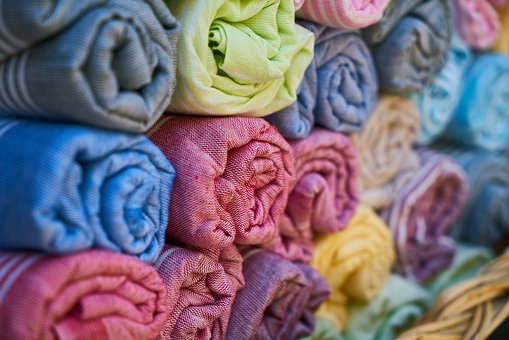Catherina Ticsay was a third-year Mechanical Engineering student at the University of Southern California. In her spare time she enjoys traveling, baking, running, and spending time with family and friends.
Since their development by NASA nearly 30 years ago, phase change materials (PCMs) have caught the attention of the textile industry because of their high capacity for heat storage. They make it possible to engineer fabrics that help regulate human body temperature. Depending on the surrounding temperature, phase change materials absorb or release heat, consequently oscillating between liquid and solid phases. Microencapsulation makes phase change materials light and portable enough to incorporate into textiles, either as a top-coat or as an addition to the fabric fibers. These “smart textiles” are currently gaining popularity in commercial garments, especially outdoor apparel. However, since PCMs are relatively new technology, there is still room for improvement in their construction and performance.
Introduction
“ At the table in the kitchen, there were three bowls of porridge.
Goldilocks was hungry.
She tasted the porridge from the first bowl.
“This porridge is too hot!” she exclaimed.
So, she tasted the porridge from the second bowl.
“This porridge is too cold,” she said.
So, she tasted the last bowl of porridge.
“Ahhh, this porridge is just right,” she said happily and she ate it all up. Goldilocks and the Three Bears
We can all relate to Goldilocks in the above excerpt, as we are also in search of a certain level of comfort and personal satisfaction. This desire is evident in our use of clothing, especially in specific articles used in cold weather. In many ways the clothes we wear may ruin or enhance our enjoyment of the outdoors. Not enough clothing will make you feel too cold; excessive layers will make you feel overly warm and bulky. How can you get that “just right” level of comfort in the clothes you wear? In recent years, the textile industry has made great strides in commercializing fabric that can help regulate body temperature. These advancements have been accomplished by engineering certain fabrics with high capacities for heat storage. Known as phase change materials (PCMs), these materials use thermodynamic principles to allow the human body to absorb and release heat when necessary. Initially created for use by NASA astronauts, phase change materials have now made their way to commercial use in textiles, creating an enhanced level of comfort that consumers will have to feel to believe.
Historical Development of PCMs
Since the invention of space suits in the 1950s, the comfort of astronauts in space has been important to NASA engineers, who were interested in engineering garments that would protect astronauts from the extreme temperature fluctuations in space (NASA). Engineers at the Lyndon B. Johnson Space Center in Texas initially developed liquid-cooled garments that ran water in small channels throughout a space suit; this suit design was categorized by NASA as an active control system. In the 1980s, NASA became interested in a more passive control system that required less energy and maintenance from both engineers and astronauts. PCMs such as lithium chloride were already in use for the heat management of instruments used in space; however, these materials were not “suitable for textile applications” (Mansfield). Pulling from heat transfer basics and previous PCM applications, NASA decided to make garments that could easily respond to the body’s thermal needs (NASA).
What is a PCM?
Thermal energy storage describes the capability of materials to store heat or cold for future use [1]. One process that utilizes thermal energy storage is the use of latent heat, which is the energy released or absorbed by a substance under constant temperature; depending on the surroundings, a material under latent heat can change phase – from solid to liquid state, liquid to gaseous state, or even solid to gaseous state [1]. Water is perhaps the best example of a substance that uses latent heat for thermal energy storage. Water in its solid state is ice. When the environment’s temperature is higher than water’s freezing point, the ice will start to melt to its liquid state. When the environment’s temperature is higher than water’s boiling point, water will boil and create steam, thereby transitioning to its gaseous state. A PCM oscillates between solid and liquid phase under a certain temperature range [2]. The material operates by the Second Law of Thermodynamics: heat transfer only flows from a material of higher temperature to a material of lower temperature. A diagram of how PCM’s functional mechanism is shown in Fig. 1. When the environment’s temperature is higher than that of the PCM, heat transfers from the surroundings to the material; this creates a cooling effect and changes PCM’s state from solid to liquid. When the environment’s temperature is lower than that of the PCM, heat transfers from the PCM to the surroundings. The stored heat is then released when the PCM changes back to its solid state, generating a warming effect. Fig. 2 features an additional interactive explanation of PCM.
What Makes a Good PCM for Commercial Use?
There are a number of substances that can act as phase change materials. The range includes salt solutions, salt hydrates, and inorganic/organic materials; however, only a few PCMs can actually be commercialized and incorporated into textiles [3]. Physical, technical, and economic factors must be considered in determining effective commercial PCMs.
Physical Factors
The physical requirements of PCMs maximize their heat storage potential and performance. The material should have a suitable phase change temperature that will satisfy the majority of consumers, from about 18ºC to 35ºC [4]. In addition, good thermal conductivity is necessary to store or release heat in a short amount of time. The PCM should also have a high storage density to accumulate a significant amount of heat, and cyclical stability to oscillate between phases for a long time period [4]. Lastly, little subcooling should occur during phase changes; subcooling is the temperature drop below the melting point that needs to be reached before the PCM solidifies [1]. Thus, the material should melt and solidify at a narrow temperature range to ensure rapid thermal response. These physical requirements demand that the PCM be efficient and quickly respond to the body’s thermal needs.
Technical Factors
Technical requirements focus on construction of the phase change material. The PCM should be chemically stable and compatible with other materials to avoid reactions. To ensure the durability and lifetime of the PCM container, the PCM should also have a low vapor pressure and undergo minimal volume change during phase changes [1]. Lastly, the PCM should be non-flammable, environmentally-friendly and non-toxic, making it safe for consumers to use [4].
Economic Factors
Economic factors such as low price and high availability may ensure the PCM’s success in the market against any other thermal heat storage competitors. While there may be a number of substances that can act as phase changing materials, there is no known material that perfectly satisfies physical and technical requirements [1]. However, the best PCMs observed for commercial use in textiles are organic materials, also known as paraffins.
PCMs in Textiles
Enhanced paraffins are known to be the most common commercial PCMs. Paraffin is another name for the group of alkanes, a hydrocarbon substance that follows the general chemical formula CnH2n+2. By adjusting the ratio of substance components, the melting and freezing points can be manipulated to the application’s desired temperatures [5]. Since hydrocarbons are known to be combustible, or flammable, the addition of flame retardants further controls the paraffin’s physical characteristics [4].
The methods of macro- and micro-encapsulation were developed to prevent the PCM from leaking while in liquid phase. Macro-encapsulation involves the placement of the PCM in a container or pocket visible to the human eye; however, micro-encapsulation is the more common method utilized to contain PCMs in textiles because of the overall portability [4]. As seen in Fig. 3, the PCM is encapsulated in a polymer shell. Encapsulation ensures extended cyclical stability of the PCM; these polymer shells must be strong enough to withstand textile incorporation, paraffin processes, and consumer use [6]. Typical sizes of the encapsulated sphere vary in micrometers, making these PCMs visible only with the aid of a microscope.
There are two popular methods for incorporating these micro PCMs (mPCMs) into fabrics. Micro PCMs can either be incorporated into the actual fabric fibers or applied as a top coat over fabrics [5]. A magnified image of mPCMs added into fabric fibers is seen in Fig. 4. While these methods of mPCM applications depend on the fabric [1], they nonetheless perform the same functions in regulating thermal body temperature.
In its solid state, when the mPCM is heated to its melting point, it absorbs heat energy, resulting in a phase change from solid to liquid form [7]. The consumer will feel a cooling effect because the PCM absorbs the excess heat. When the PCM’s surroundings are below its freezing point, the mPCM will release the stored heat energy and solidify again, generating a temporary level of warmth for the consumer [7]. mPCMs quickly react to temperature changes in the environment and in different areas of the body, significantly improving the thermal insulation of cold weather outdoor apparel [2]. The addition of mPCMs gave rise to a new type of fabric known as “smart textiles.”
Commercial Development of PCMs
Building from the idea of a passive control system, NASA teamed up with Triangle Research and Development in 1987 to develop the first encapsulated paraffin PCMs for use in space suits [2]. Several years later, Gateway Technologies acquired the exclusive patents from Triangle Research and Development and were the first to make PCMs accessible to consumers through apparel. Now known as Outlast Technologies, the company has partnered with popular outdoor brands in commercializing PCMs. By 2003, “smart textiles” were featured in nearly every major outdoor apparel brand such as Eddie Bauer, Burton, Timberland and The North Face [8]. With success in parkas, gloves, and thermal underwear, the application of PCMs continues to further expand into other forms of textiles such as everyday clothing, athletic apparel, socks, bedding, footwear, and even car seats [2].
Perhaps the overall challenge facing “smart textiles” is enhancing the PCM to make the warming effects last longer. Several experimental tests analyzing the effects of PCMs in clothing garments, compared to those without PCMs, have been carried out in recent years. The conclusions of these experiments have determined that while thermal insulation using mPCMs is improved, its warming effects are only temporary [9]. While incorporating more mPCMs seems to be the intuitive solution, not only will this increase costs, it will decrease the durability of fabrics (Salaün). The addition of more mPCMs may also add more dead weight to the clothing garment, thus defeating the intent of smart textiles to eliminate the bulk that characterizes typical outdoor apparel.
Since commercial use of PCMs in textiles is relatively new, there is still much potential for improvement on how PCMs are made and their overall performance. Nevertheless, the future looks bright for PCMs. There have even been proposed possible uses in the medical field and in the heating and cooling of buildings (Mehling). The applications of PCMs seem to be numerous and definitely extend beyond textiles. “Smart textiles” is beginning to assume an important role in daily life and the comfort of consumers, something that even Goldilocks would appreciate.
References
-
- [1] H. Mehling and L. Cabeza. Heat and Cold Storage with PCM. Berlin, Germany: Springer, 2008, pp.1-207.
- [2] R. Mansfield. “Phase Change Materials.” Textile World. Internet: http://www.textileworld.com/Articles/2004/March/Features/Phase_Change_Materials.html, Mar. 1 2004 [Jul. 12, 2010].
- [3] B. Zalba, J. Marin, L. Cabeza, and H. Mehling. (2003) “Review on thermal energy storage with phase change: materials, heat transfer analysis and applications.” Applied Thermal Engineering. [On-line]. 23 (1): 251–283. Available: http://www.sciencedirect.com. [Jul. 12, 2010].
- [4] S. Mondal. (2007) “Phase change materials for smart textiles – An overview.” Applied Thermal Engineering. [On-line]. 2007: n. pag. Available: http://www.sciencedirect.com. [Jul. 12, 2010].
- [5] H. Shim, E.A. McCullough, and B.W. Jones. (Jun. 2001) “Using Phase Change Materials in Clothing.” Textile Research Journal. [On-line]. June 2001: 495-502. Available: http://trj.sagepub.com/cgi/content/abstract/71/6/495. [Jul. 12, 2010].
- [6] F. Salaün, E. Devaux, S. Bourbigot, and P. Rumeau. (2009) “Development of Phase Change Materials in Clothing Part I: Formulation of Microencapsulated Phase Change.” Textile Research Journal. [On-line]. 80(3): n. pag. Available: http://trj.sagepub.com/cgi/content/abstract/80/3/195. [Jul. 12, 2010].
- [7] “Outlast” Internet: http://www.outlast.com/. 2010. [Jul. 12, 2010].
- [8] T. Staedter. (Mar. 2002). “Phase Change Material: Microcapsules that Keep You Comfy.” Technology Review. [On-line]. 105(2): 88-89. Available: http://www.techreview.com. [Jul. 12, 2010].
- [9] B. Ying, Y. Kwok, Y. Li, Q. Zhu, and C. Yeung. (2004) “Assessing the performance of textiles incorporating phase change materials.” Polymer Testing. [On-line]. 23: 541–549. Available: http://www.sciencedirect.com. [Jul. 12, 2010].




